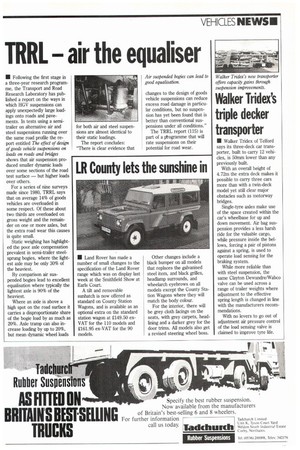TRRL air the equaliser
Page 15

If you've noticed an error in this article please click here to report it so we can fix it.
• Following the fu-st stage in a three-year research programme, the Transport and Road Research Laboratory has published a report on the ways in which HGV suspensions can apply unexpectedly large loadings onto roads and pavements. In tests using a semitrailer on alternative air and steel suspensions running over the same road profile the report entitled The effect of design of goods vehicle sus-pensions on loads on roads and bridges shows that air suspension produced smaller dynamic loads over some sections of the road test surface — but higher loads over others.
For a series of nine surveys made since 1980, TRRL says that on average 14% of goods vehicles are overloaded in some respect. Of these about two thirds are overloaded on gross weight and the remainder on one or more axles, but the extra road wear this causes is quite small.
Static weighing has highlighted the poor axle compensation prevalent in semi-trailer steelsprung bogies, where the lightest axle may be only 30% of the heaviest.
By comparison air suspended bogies lead to excellent equalisation where typically the lightest axle is 90% of the heaviest.
Where an axle is above a high spot on the road surface it carries a disproportionate share of the bogie load by as much as 20%. Axle tramp can also increase loading by up to 20%, but mean dynamic wheel loads for both air and steel suspensions are almost identical to their static loadings.
The report concludes: "There is clear evidence that changes to the design of goods vehicle suspensions can reduce excess road damage in particular conditions, but no suspension has yet been found that is better than conventional suspensions under all conditions."
The TRRL report (115) is part of a plrogramme that will rate suspensions on their potential for road wear.
































































































